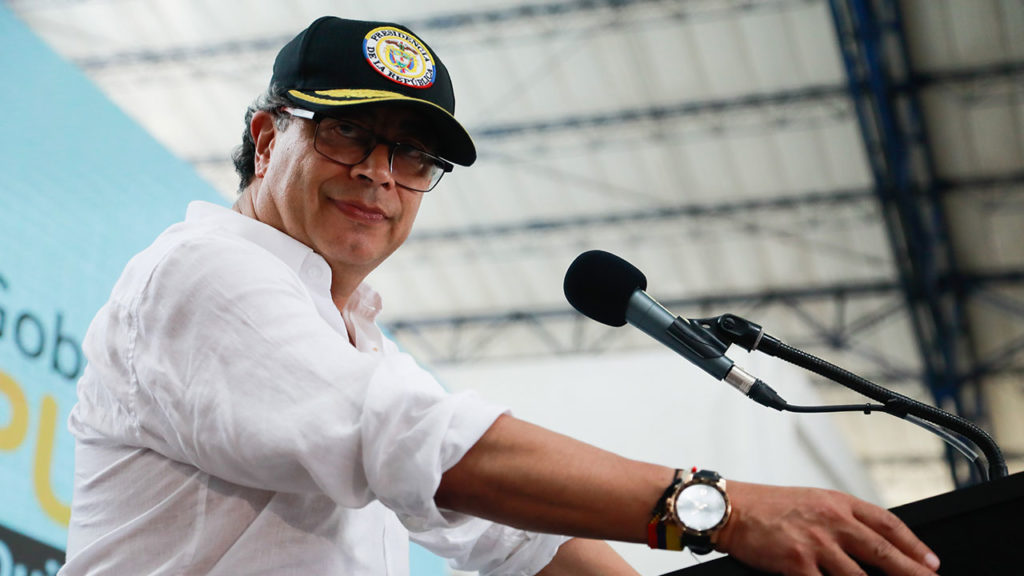
This weekend, Gustavo Petro, the President of Colombia, introduced the proposal to construct an interoceanic canal in the Choco region of Colombia, via railroad. The envisioned canal aims to connect the Atlantic and Pacific oceans, positioning it as a competitor to the Panama Canal. Petro announced this ambitious project during his visit to the department, where he also pledged to address key issues, including the provision of drinking water and the enhancement of healthcare services.
In November of the previous year, the Colombian President shared a similar vision on his social networks, expressing his ambition to develop a railway network in Choco. This proposed network would not only connect with Colombia’s central region but also establish a linkage with the Panama Canal, potentially creating a significant transportation corridor
Choco, a department long overlooked by the state, was recently thrust into the spotlight following a devastating landslide on a highway that claimed 39 lives. This tragedy underscored the plight of the region, predominantly inhabited by a black population, which has historically been sidelined by public authorities. Addressing this issue, the current Colombian President condemned previous governments for treating Choco as the ‘back door of Colombia.’ He affirmed his administration’s commitment to repositioning the Pacific Coast as the ‘front door of Colombia,’ signaling a shift in the region’s significance.
Competing with Panama
The ambition to rival the Panama Canal is a longstanding one shared by several countries in the region. For years, Nicaragua has publicized plans to construct a maritime route connecting the two oceans. Now, Gustavo Petro, the Colombian President, is proposing a novel approach: a railroad connection running parallel to a canal.
Choco, uniquely positioned with coastlines on both the Pacific and Atlantic Oceans, shares a border with Panama, adjoining the rugged Darien region. Amidst his address to the Chocoan populace, the Colombian President proposed a regional consultation to assess citizen support for constructing a railroad that would link the two oceans. This initiative represents a significant step in gauging local sentiment towards this ambitious infrastructural project.
“The only department in Colombia that has coasts on both oceans is Choco. Shouldn’t it be the richest? (…) That makes the channels possible, whether by rail or water. Of course it is possible and more than one is thinking about it”, he stated before the citizens who attended the event.
The president pointed out that the Panama Canal, in addition to being congested, is drying up, presenting problems for its future navigation, and an opportunity for the Colombian region.
“A miner in Istmina (a town in the region) was asking me if I knew what it would mean to build such an infrastructure at the mouth of the Atrato River (…) The Internet says that it is 11 meters deep (…) What happens if a canal is built in that body of water, which means digging the soil of the bed to the dimension that corresponds to allow large ships to pass?”, said the president.

Investment plan for the Pacific coast
The Colombian Pacific coast, encompassing departments like Choco, Valle del Cauca, Cauca, and Nariño, has historically seen minimal public investment. In response to this long-standing issue, the Colombian President announced a significant investment package totaling 2 trillion pesos, targeting three of these departments. This initiative marks a substantial shift in the government’s approach to developing this region
“Getting out of poverty is to be able to live intensely the existence we have for as long as we have. Getting out of poverty implies working and producing, replacing the illicit economy with a licit economy”, said Petro in the week in which his government departed from the Pacific region.
The planned investments primarily aim to enhance transportation and connectivity in the Choco, Cauca, and Nariño regions. William Camargo, the Minister of Transportation, stated that these projects are scheduled to commence in 2024 and will extend over several years. This initiative represents a significant commitment to improving the infrastructure in these historically underdeveloped areas.
Investments in the field
According to the government, the Choco region will have an investment of 1.4 billion pesos, of which 500 billion will be used to attend to the Quibdo – Medellin corridor, affected this month by the tragedy that killed 39 people due to landslides.
Similarly, over the next few years, 140 billion pesos will be allocated to develop the Belen de Bajira – Riosucio section, with 20 billion pesos earmarked for 2024. Additionally, Choco is set to receive further investments for various infrastructure projects. These include upgrading the runways at Bahia Solano and Bajo Baudo airports; maintaining the Quibdo – Pereira road; implementing the Community Roads for Total Peace program; developing the Quibdo dock; and planning the Belen de Novita – Cartago section. These initiatives reflect a comprehensive approach to enhancing the region’s transportation and connectivity infrastructure.
In the department of Cauca, an investment totaling 330 billion pesos is earmarked for a range of transportation infrastructure projects. These projects encompass preparatory studies for the enhancement of the Guapi airport, improvements in the connectivity between the municipalities of Timbiqui and Lopez de Micay, as well as the development of the Suarez – Morales and El Plateado – Argelia sections. This significant financial commitment underscores the government’s focus on upgrading and expanding the transportation network in Cauca.
Concluding this series of investments, the department of Nariño is set to receive 300 billion pesos for various key projects. These include upgrades for the La Florida airport in Tumaco, construction of the new Magüí Payán airport, dredging operations for the rehabilitation of the Tumaco port, maintenance and enhancement of the Pedregal – Tumaco road, and improvement works on the Telembi Bridge. This allocation demonstrates a significant commitment to advancing the infrastructure and connectivity within Nariño.
See all the latest news from Colombia and the world at ColombiaOne.com. Contact our newsroom to report an update or send your story, photos and videos. Follow Colombia One on Google News, Facebook, Instagram, TikTok and subscribe here to our newsletter.


